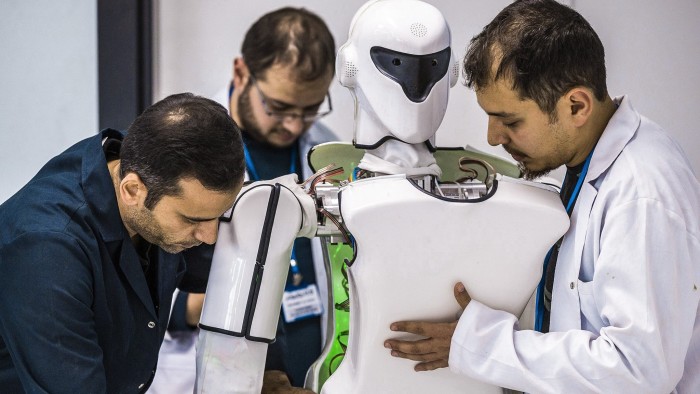Davos 2018: why automation may be more evolution than revolution

Roula Khalaf, Editor of the FT, selects her favourite stories in this weekly newsletter.
The talk was that automation was going to imperil the jobs of millions of workers, leading to an “industrial revolution of unmitigated cruelty”. The concern was that robot weapons would run out of control, leading to unconscionable slaughter on a mass scale. The terror was that every degree of independence given to machines would increase the possible defiance of our wishes: “The genii in the bottle will not willingly go back in the bottle, nor have we any reason to expect them to be well disposed to us.”
These were not views expressed recently by some neo-Luddite. They were opinions from the late 1940s of one of the pioneers of the information age, Norbert Wiener, known as the father of cybernetics.
As John Markoff says in his 2015 book Machines of Loving Grace: The Quest for Common Ground Between Humans and Robots, fears of automation have been a cyclical phenomenon for more than 70 years — as have the excessive, near religious promises for the transformative powers of new technologies.
That history is worth bearing in mind as we confront the promise and perils of the fourth industrial revolution, the watchword of the World Economic Forum. It is worth remembering that the phrase “fourth industrial revolution” is also not new but was first used in 1940 by US author Albert Carr, who argued that only a new technological revolution could save western democracy. It has since been applied to successive revolutions ushered in by nuclear energy, electronics and the computer.
The critical question for policymakers and business executives is to what extent the latest generation of technologies is going to transform our economies and societies. Do they represent a fundamental change or merely an incremental improvement?
Some economists, including Tyler Cowen and Robert Gordon, say one of the most striking features of the modern economy is how little innovation there has been, rather than how much. Much of the low-hanging technological fruit has been picked and it is becoming harder to innovate on a transformational scale. The era between 1870 and 1940 of great inventions, such as electrical power, indoor plumbing and powered flight, is over.
“What is remarkable about the American experience is not that growth is slowing down but that it was so rapid for so long,” wrote Professor Gordon in The Rise and Fall of American Growth, published in 2016.
The response of Paul Krugman, the Nobel Prize-winning professor of economics at the City University of New York, was a “definite maybe”: he suggested that although Prof Gordon’s analysis of economic history was impeccable, we cannot extrapolate from the present to predict the future.
However, a vociferous school of techno-optimists is dismissive of the stagnation thesis and argues we are on the brink of a massive transformation as the era of big data and artificial intelligence unfolds.
A report last year by the US Technology CEO Council had few doubts the latest technologies were a game changer. They estimated that the effects of the information revolution had transformed just 30 per cent of the US private-sector economy, and that applying such technologies to the rest of the private sector would boost the size of the US economy by $2.7tn by 2031.
The authors, Michael Mandel and Bret Swanson, wrote: “With the arrival of powerful new technologies, we stand on the verge of a productivity boom. Just as networking computers accelerated productivity and growth in the 1990s, innovations in mobility, sensors, analytics and artificial intelligence promise to quicken the pace of growth and create myriad new opportunities for innovators, entrepreneurs and consumers.”
Rather than trying to guess the macro impact of these new technologies, though, we might be better advised to study the real-world changes they are bringing about. Increasingly, AI systems are deployed across a range of functions to improve search engine results, drive cars, cut energy usage at data farms and boost productivity at industrial plants.
To take one example, Yandex Data Factory, the Amsterdam-based offshoot of the Russian tech company, has been working with Russia’s Magnitogorsk Iron and Steel Works to optimise its production processes, leading to a 5 per cent reduction in ferroalloy use and an annual saving of $4m.
Yandex studied seven years of smelting data and used a real-time machine-learning system to calculate the optimal “recipe” of ingredients to produce the best steel with the least energy.
Jane Zavalishina, Yandex chief executive, says such techniques could be used to lift the productivity of all kinds of processing industries. “Our algos have got quite good at dealing with unstructured data. We can . . . come up with better predictive models,” she says. “I am sure there are hundreds of other potential cases across different industries.”
Sometimes the accumulation of such incremental improvements can lead to fundamental change. So, too, it may be with the latest automation technologies.
Comments